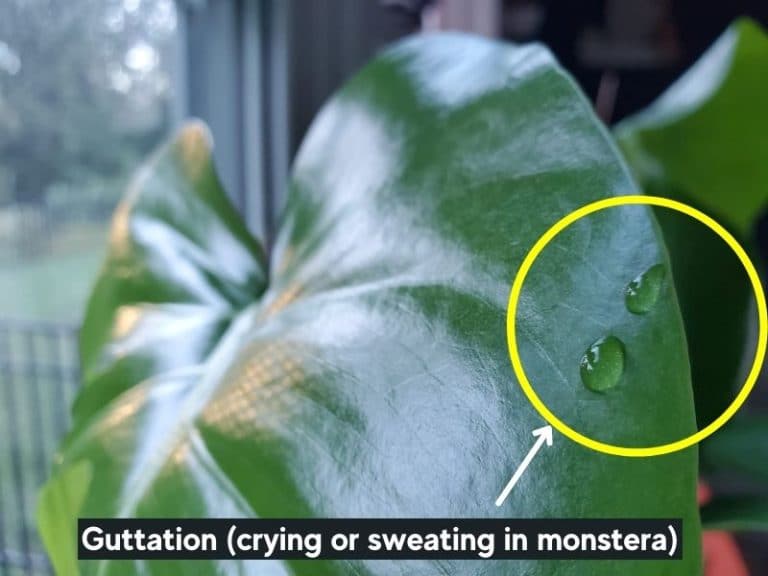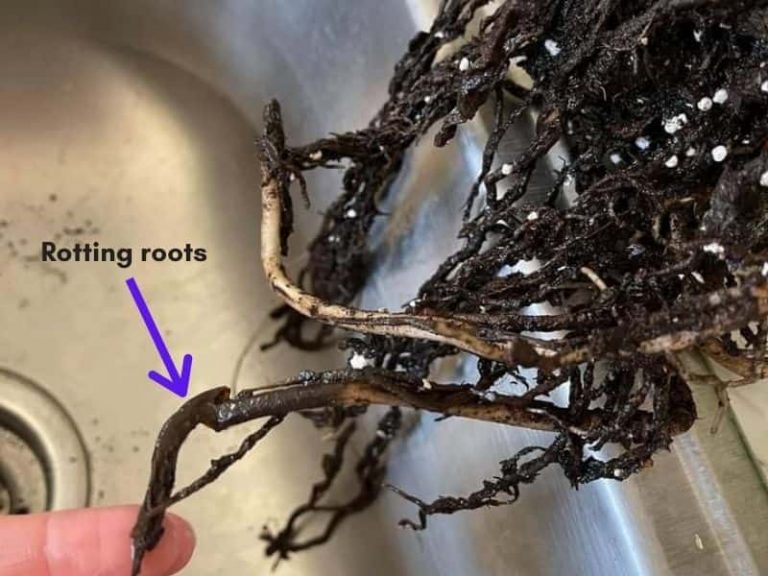Overwatered Monstera: Signs + How to Save the Swiss Cheese Plant
Monstera plant (the Swiss cheese plant) has large leaves that easily stand out, making it an excellent choice for home decoration. However, the plant is vulnerable to temperature changes and overwatering and can show undesirable signs such as drooping and discolored spots on the foliage if not well taken care of.
What are the signs of overwatering in monstera and how do you save the plant?
The signs of an overwatered monstera include leaves turning yellow, drooping, and forming brown spots. Repot the monstera in a well-draining potting mix to save it from root rot. Water the plant lightly to keep the soil moist, and allow the top 2-3 inches of the soil to dry before watering again.
Signs of an overwatered monstera
A few symptoms of an overwatered monstera will help you determine if yours is overwatered. By denying the roots of oxygen and removing essential nutrients from the soil, overwatering is particularly dangerous to your monstera (and negatively affects its health).
Besides, overwatering makes your plant susceptible to diseases such as root rot, fungi, and bacterial infections that can be difficult to treat.
Here are the signs of an overwatered monstera:
Yellow or dark brown spots on leaves
Your monstera leaves might turn yellow because of several reasons, such as overwatering. Excess water is one of the primary reasons for yellowing leaves (which indicates that the same is negatively affecting the plant’s health).
Excess water forces the oxygen from the soil, which causes the roots to become clogged and reduces their performance. If left unchecked for a considerable time, the roots suffocate, drown, and rot.

The inability of the root system to absorb water and other essential minerals causes the leaves to turn yellow or have dark spots of brown.
You might also notice drooping leaves, indicating your plant has water issues. It’s crucial to ensure your soil dries out between watering to safeguard against such instances.
Foul smell from the pot
You might notice a foul smell within the potting medium. The odor indicates bacterial activity commonly caused by overwatering, poor drainage, and aeration.
Bacteria can negatively impact the health of your plant. The smell is primarily an indicator of anaerobic respiration, oxygen deprivation and deserves attention.
Overwatering is the leading cause of foul-smelling soils and potting mediums, so be sure to preserve the health of your monstera by removing it from the affected surface.
Fungi on the soil
The presence of fungi in the soil is easy to detect. Fungi species appear naturally in nature (and are usually harmless), but some varieties might have detrimental effects on your potting medium and your plant’s health.
A primary indicator of fungi infections on your monstera includes the appearance of long, white threads on your soil close to the base of your plant (you might also notice the appearance of mold close to the base of your plant).
Overwatering promotes the growth of fungi (and might cause root rot) to the sensitive parts of your plant.
If you suspect that your potting is suffering from a fungal infection, a good idea would be to take a handful of soil to a lab for further testing and analysis to determine the type of fungi affecting your plants (and how best to get rid of the infection).
Waterlogged soil taking over a week to dry out
Waterlogging is a primary indicator of overwatering, where water takes a long time to dry out.
Waterlogging harms your plant’s health because monstera prefers well-drained soils that can easily shed excess water.
Choosing an ideal potting medium also helps deal with waterlogging incidences, plus a drainage hole at the bottom of your pot helps easily get rid of excess water.
Root rot
Root rot is commonly caused by overwatering. The sickness affects the root’s ability to take in water and other essential nutrients, which can cause your plant to dry out if not dealt with soon.
Excess water and soggy soils promote the growth of Pythium, aphanomyces, and other fungi species commonly linked with the disorder.
In some cases, when the damage is too severe, you might have to uproot the plant, cut off the affected sections, and apply fungicides to deal with the issue.
How to revive an overwatered monstera
It is possible to revive a drooping monstera delicosa or adansonii from overwatering if it has not developed severe root rot. The most important part is to drain the excess water from the soil then give your pots plenty of time to dry.

Overwatering a monstera can have secondary implications, which you might have to consider if you are keen on returning our plant to its optimum health.
Here’s how to revive an overwatered monstera:
1. Withhold watering and drain the potting soil
It’s crucial to withhold from watering your plant until you are sure that the excess water has drained.
Water your monstera adansonii at least once or twice a week (depending on the climate in your area). Before adding water to your plant, make sure the top layer of the potting has completely dried out (about 1-2 inches).
2. Check for root rot indicators
Root rot is a detrimental consequence of overwatering. Some common symptoms of root rot include drooping leaves, foul smell, and dark brown spots within the roots of your plant.
It’s crucial to change the potting medium and cut off any rotting roots to prevent the spread of the infection to more parts of the plant. Apply a fungicide to help stop the spread of disease (and eradicate the fungi from your soil).
Ensure you adhere to your watering schedule, and conduct frequent evaluations to check on the health state of your plant.
3. Change potting medium
Changing the potting medium can control waterlogging, root rot, and other effects of excessive watering. Besides, monstera are typically large plants that might require an occasional change of growing pots to accommodate an increase in size.
Monstera grow well under a potting mix of well moist, well-drained soils with a relative pH ranging from 5.5-6.5. You can also add peat moss and pine bark fines in a ratio 1:4.
Choosing an ideal potting medium helps you control water retention and temperature and provides a stable anchor for your plant.
4. Change the growing container
It’s crucial to choose an ideal growing pot for your monstera adansonii or delicosa. When picking a quality pot, you might have to consider the size of the vessel concerning the plant, drainage features, and the material that makes up the pot. (A good growing pot should leave about one-one and a half inches of space on each side).
Ensure your roots snugly fit within the pot before adding any potting medium. Some monstera plants have aerial roots, which might linger above the surface, but the remainder will fit within the vessel.
Choosing a pot with drainage holes is also advisable to allow it to shed off excess water. Double potting is also an option (and can be especially useful when you have growing pots that don’t fit the interior of your house).
Overwatered vs. Underwatered Monstera
Identifying an under-watered monstera from an overwatered plant of the same species can be challenging to some people.
Both cases share several similarities that make it quite tricky to tell whether you’re overwatering or underwatering your plants. Depending on whether your plant is overwatered or not getting enough water, you will be able to distinguish between the two.
Here’s how to tell an overwatered from an underwatered Swiss cheese plant:
| Overwatered Monstera | Underwatered Monstera |
| Constant wet soil | Soil is dry and brittle |
| Lower leaves turn yellow, brown | Leaves drop, curl before turning brown |
| Foul smell in soil | No smell in soil |
| Plant stops growing new leaves | New leaves appear, although at a slower rate |
| Roots become mushy, black/brown | Your rhizomes feel papery and thin |
Can you overwater a Swiss cheese plant?
It is not a good idea to overwater your monstera because the plant is sensitive to extreme moisture changes in its soil. Allow the Swiss cheese plant’s soil to dry out between waterings, and ensure the pot has enough drainage holes to prevent waterlogging.
Swiss cheese plants (Monstera adansonii and Monstera delicosa) only need a little bit of water about once a week, making them an ideal choice for beginners.
Ensure your plant potting has drainage holes on the underside to prevent waterlogging. Giving the soil a few minutes (10-20 min) between watering is also crucial to give it enough time to soak.
Monstera generally prefers moist, well-draining soils and is vulnerable to overwatering. It’s also advisable to ensure you water your plant from the base, as it increases the root’s strength given that they grow downwards towards the moisture.




